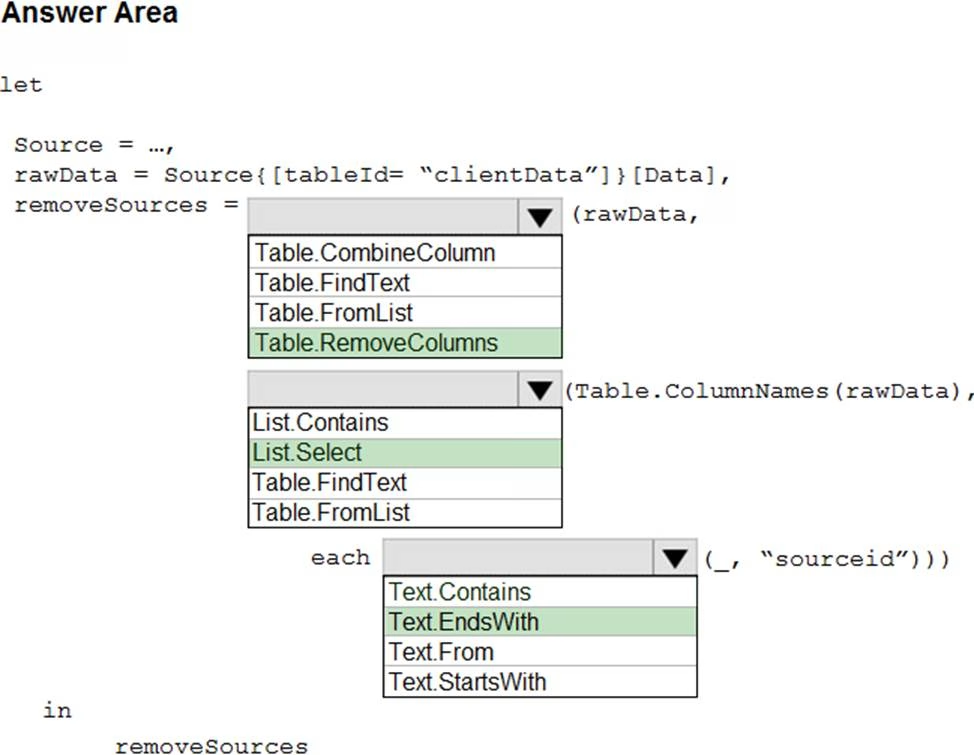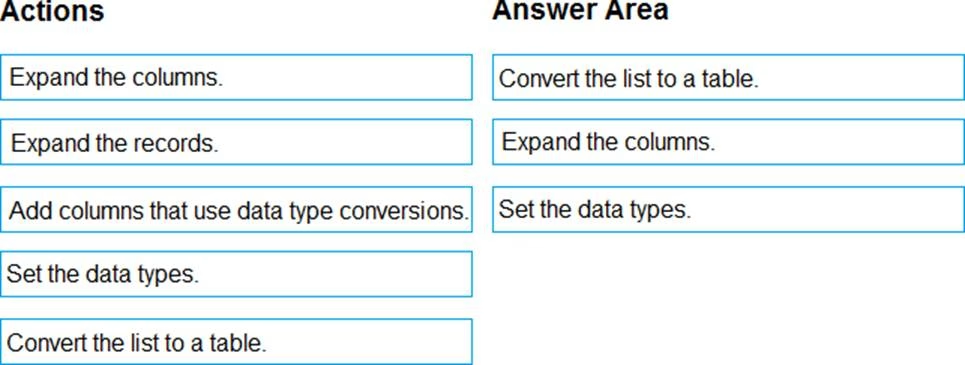Microsoft PL-300 Microsoft Power BI Data Analyst Online Training
Microsoft PL-300 Online Training
The questions for PL-300 were last updated at Dec 10,2025.
- Exam Code: PL-300
- Exam Name: Microsoft Power BI Data Analyst
- Certification Provider: Microsoft
- Latest update: Dec 10,2025
You have a large dataset that contains more than 1 million rows. The table has a datetime column named Date.
You need to reduce the size of the data model.
What should you do?
- A . Round the hour of the Date column to startOfHour.
- B . Change the data type of the Date column to Text.
- C . Trim the Date column.
- D . Split the Date column into two columns, one that contains only the time and another that contains only the date.
You have a custom connector that returns ID, From, To, Subject, Body, and Has Attachments for every email sent during the past year. More than 10 million records are returned.
You build a report analyzing the internal networks of employees based on whom they send emails to.
You need to prevent report recipients from reading the analyzed emails. The solution must minimize the model size.
What should you do?
- A . Implement row-level security (RLS) so that the report recipients can only see results based on the emails they sent.
- B . Remove the Subject and Body columns during the import.
- C . From Model view, set the Subject and Body columns to Hidden.
You have the tables shown in the following table.
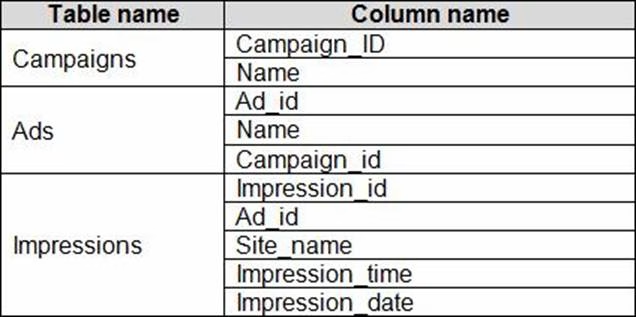
The Impressions table contains approximately 30 million records per month.
You need to create an ad analytics system to meet the following requirements:
✑ Present ad impression counts for the day, campaign, and Site_name. The analytics for the last year are required.
✑ Minimize the data model size.
Which two actions should you perform? Each correct answer presents part of the solution. NOTE: Each correct selection is worth one point.
- A . Group the impressions by Ad_id, Site_name, and Impression_date. Aggregate by using the CountRows function.
- B . Create one-to-many relationships between the tables.
- C . Create a calculated measure that aggregates by using the COUNTROWS function.
- D . Create a calculated table that contains Ad_id, Site_name, and Impression_date.
Your company has training videos that are published to Microsoft Stream. You need to surface the videos directly in a Microsoft Power BI dashboard.
Which type of tile should you add?
- A . video
- B . custom streaming data
- C . text box
- D . web content
You open a query in Power Query Editor.
You need to identify the percentage of empty values in each column as quickly as possible.
Which Data Preview option should you select?
- A . Show whitespace
- B . Column profile
- C . Column distribution
- D . Column quality
You have a prospective customer list that contains 1,500 rows of data.
The list contains the following fields:
✑ First name
✑ Last name
✑ Email address
✑ State/Region
✑ Phone number
You import the list into Power Query Editor.
You need to ensure that the list contains records for each State/Region to which you want to target a marketing campaign.
Which two actions should you perform? Each correct answer presents part of the solution. NOTE: Each correct selection is worth one point.
- A . Open the Advanced Editor.
- B . Select Column quality.
- C . Enable Column profiling based on entire dataset.
- D . Select Column distribution.
- E . Select Column profile.
HOTSPOT
You have an API that returns more than 100 columns.
The following is a sample of column names.
✑ client_notified_timestamp
✑ client_notified_source
✑ client_notified_sourceid
✑ client_notified_value
✑ client_responded_timestamp
✑ client_responded_source
✑ client_responded_sourceid
✑ client_responded_value
You plan to include only a subset of the returned columns.
You need to remove any columns that have a suffix of sourceid.
How should you complete the Power Query M code? To answer, select the appropriate options in the answer area. NOTE: Each correct selection is worth one point.
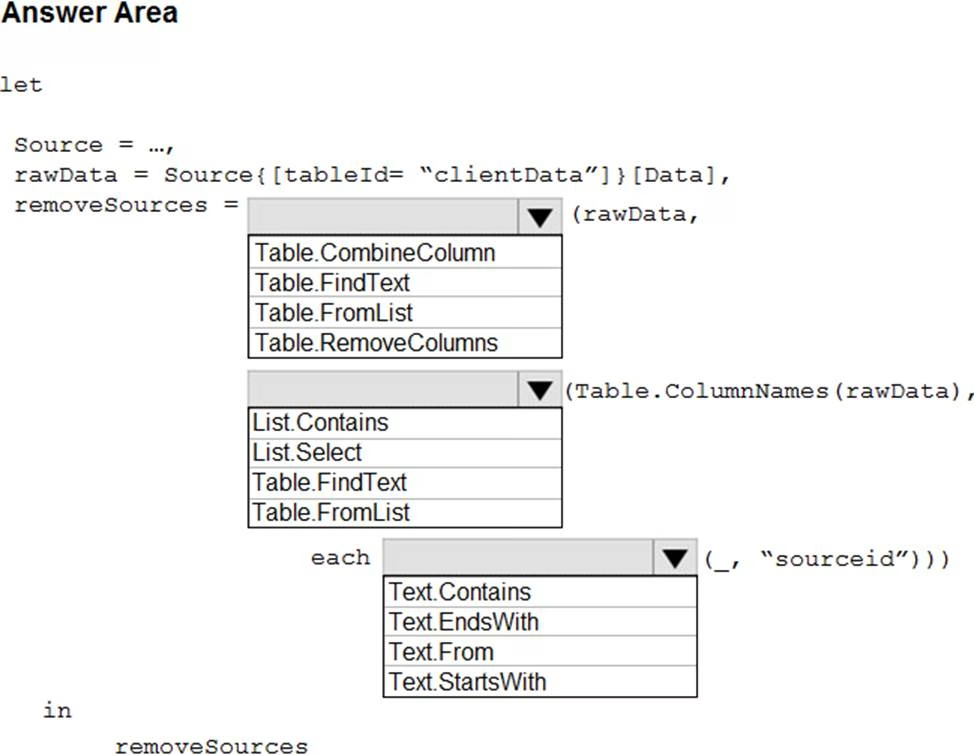
DRAG DROP
You are building a dataset from a JSON file that contains an array of documents.
You need to import attributes as columns from all the documents in the JSON file. The solution must ensure that date attributes can be used as date hierarchies in Microsoft Power BI reports.
Which three actions should you perform in sequence? To answer, move the appropriate actions from the list of actions to the answer area and arrange them in the correct order.
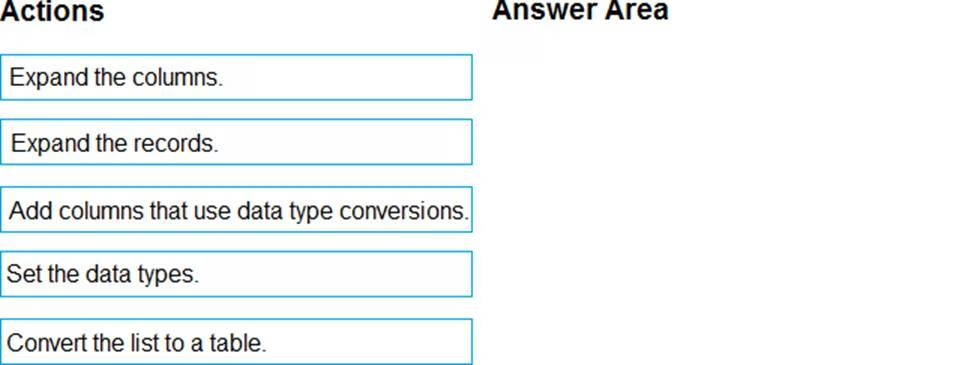
You import two Microsoft Excel tables named Customer and Address into Power Query.
Customer contains the following columns:
✑ Customer ID
✑ Customer Name
✑ Phone
✑ Email Address
✑ Address ID
Address contains the following columns:
✑ Address ID
✑ Address Line 1
✑ Address Line 2
✑ City
✑ State/Region
✑ Country
✑ Postal Code
The Customer ID and Address ID columns represent unique rows.
You need to create a query that has one row per customer. Each row must contain City, State/Region, and Country for each customer.
What should you do?
- A . Merge the Customer and Address tables.
- B . Transpose the Customer and Address tables.
- C . Group the Customer and Address tables by the Address ID column.
- D . Append the Customer and Address tables.
You have the following three versions of an Azure SQL database:
✑ Test
✑ Production
✑ Development
You have a dataset that uses the development database as a data source.
You need to configure the dataset so that you can easily change the data source between the development, test, and production database servers from powerbi.com.
Which should you do?
- A . Create a JSON file that contains the database server names. Import the JSON file to the dataset.
- B . Create a parameter and update the queries to use the parameter.
- C . Create a query for each database server and hide the development tables.
- D . Set the data source privacy level to Organizational and use the ReplaceValue Power Query M function.
Latest PL-300 Dumps Valid Version with 131 Q&As
Latest And Valid Q&A | Instant Download | Once Fail, Full Refund

